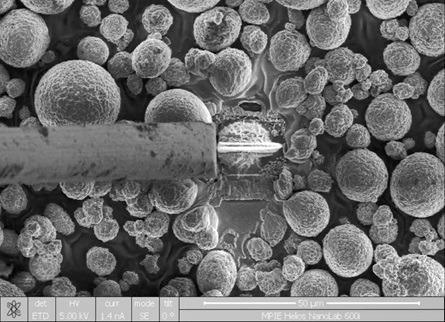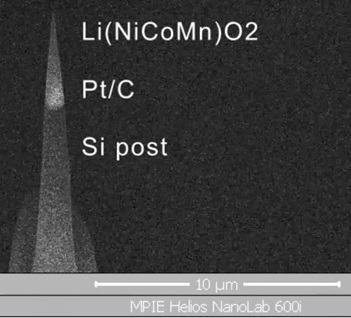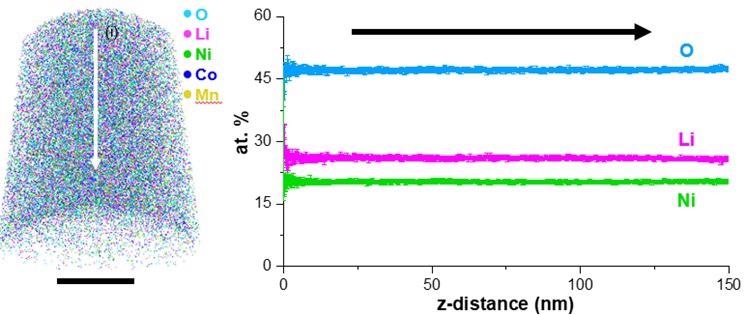Li-ion batteries (LIB) are considered the principal means of accomplishing large-scale, high-capacity energy storage that is needed for electric vehicles or for grid energy storage in today’s world. A Li-ion battery is made up of anode, cathode and electrolyte; as the battery charges, Li ions travel from cathode to anode via the electrolyte, and the reverse reaction occurs during discharge.
Understanding LIB degradation mechanisms as the charge/discharge cycle takes place is crucial to reducing their cost and impact on the environment. This fundamental research into the mechanics of battery materials is centered on understanding the development of microstructure and chemistry under operating conditions at the nanoscale.
For a better understanding of nanoscale chemistry and microstructure of LIB, electron and ion beam-based methods (SEM, TEM, FIB), in addition to Atom Probe Tomography (APT), have demonstrated themselves as vital techniques. The chemistry of LIB components makes them notoriously difficult to analyze due to a possible interaction with an electron or ion beam.
Therefore, other considerations and specialized techniques must be employed to prepare such samples to be analyzed further in either TEM or APT. Recently, a paper from Se-Ho Kim, Stoichko Antonov and collaborators offered a detailed exploration of various methodologies for the evaluation of LIB samples in Atom Probe, especially the use of plasma FIB (Thermo Fisher Helios Xe PFIB) as a preparation method.
Taking advantage of their experiences from the world-renowned Max Planck Intitut für Eisenforschung GmbH (group of Dr. Baptiste Gault), the authors have also conducted work with FIB and APT in the fields of physical metallurgy and 3D analysis of nanoparticles and have united to explore a similar approach for nanoscale analysis for LIB materials.
We wanted to try the APT approach on battery materials for a while and had many requests from colleagues to attempt this analysis. This was an interesting problem.
Stoichko Antonov
Their aim was to investigate the influence of various types of FIB preparation on sample integrity and the resulting fidelity of APT analysis.
In the case of LIB materials, the challenge stems from the complexity of the sample chemistry. Some of the main problems associated with FIB-prepared LIB samples and APT analysis include ion implantation, ion-beam induced melting, internal open pores or cracks generated throughout the process, as well as Li-ion mobility induced during the experiment.
Initially, the team attempted using a conventional Ga ion beam to fabricate the needle-shaped tip needed for APT; however, they soon realized that the application of Ga significantly modifies the adopted structure of the specimen and, as a result, changes the results prior to conducting the APT experiment.
Conventional Ga ion beam approach to sample preparation has been attempted for a variety of battery materials (NMC, NMA type chemistries as an example), with mixed results due to specimen damage cause by ion-beam/specimen interaction.
The primary approach in their research used plasma-FIB (Xe), which demonstrated no reaction with Al species and did not yield any structural modification.
Their novel methodology used a more conventional TEM lamella preparation technique as an initial step in the lift-out procedure for generating an APT-appropriate needle sample, rather than the inversed pyramidal shape procedure fostered by the atom probe community.
The most interesting part of the paper was focused on discussing the effectiveness of the cryo-FIB technique for sample preparation before Atom Probe analysis.
In my opinion, it highly depends on the material. If there is Ni inside, it is better to expose the sample to air and develop a passivation layer. If there is Li present, then the approach should involve an inert transfer and cryo-FIB preparation.
Se-Ho Kim
Moreover, the authors implied that the approach should be led not only by the sample chemistry but also by the scientific question the researcher is trying to clarify.
Stoichko and Se-Ho both stated, “If the ultimate goal is to understand battery degradation mechanism, preservation of the sample becomes of utmost importance - prior to sample transfer in and out of glove box and between FIB and APT.”
The group is also actively pursuing a similar approach to other beam or environment-sensitive materials, including other alkali metals like Na. They predict that those materials will necessitate a delicate balance of cryoFIB and inert transfer to avoid potential sample melting and structure modification.

Image Credit: Se-Ho Kim and Stoichko Antonov from MPIE, Max Planck Intitut für Eisenforschung GmbH

Image Credit: Se-Ho Kim and Stoichko Antonov from MPIE, Max Planck Intitut für Eisenforschung GmbH

Image Credit: Se-Ho Kim and Stoichko Antonov from MPIE, Max Planck Intitut für Eisenforschung GmbH
Reference:
- https://pubs.rsc.org/en/content/articlelanding/2022/TA/D1TA10050E

This information has been sourced, reviewed and adapted from materials provided by Thermo Fisher Scientific – Materials & Structural Analysis.
For more information on this source, please visit Thermo Fisher Scientific – Materials & Structural Analysis.